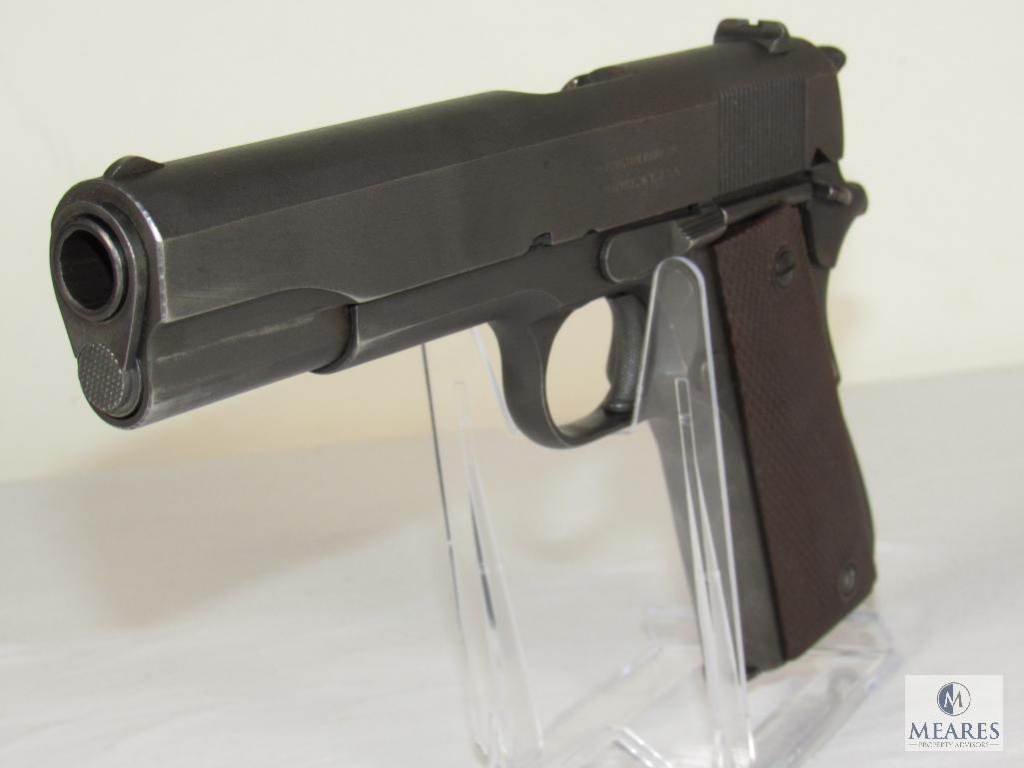

Xavier has been an avid shooter for over 30 years. He often provided nursing service in areas where law enforcement refused to enter without back-up. He has practiced for over fourteen years in his community. Xavier is a Registered Nurse who specialized in complex wound care. Sometimes lady luck smiles in a grand fashion. A beautiful Du-Lite finish, all original and retains about 90% finish. My only Remington Rand (so far - I have nine M1911s and -a1s) is one of the first 1000 made. It is in fact dark brown, as the pics at The High Road show. The holster appears to be black in the photo. The black leather holster indicates post WW2 issue (I think around 1950 is when they switched) most original tan holsters were dyed black. 107 of Claweson's 3rd Edition book (which I have) - wanna trade? :-) My magazines are a Scovill and a Risdon and it digests WalMart white-box FMJ with nary a hiccup. My '43 Colt 1911A1 has a High Standard barrel, marked HS on the right side of the toggle lug, P on the left side just like p.

The slidestop and the thumb safety rarely have the same parkerizing color the rest of the pistol has. And all meet the description in Clawson's book. Also, check the color of the parkerizing on the slide and on the frame. There are others like F for Flannery Bolt Company and Coltznd Springfield in early production.
#Remington rand 1911a1 history serial
The markings that were on the WW 2 Remington Rand barrels should be HS (manufactured by High Standard) on the right lug for a serial number, such as yours, that late in production. My main reference is Charles Clawson's excellent "Colt. 45 I believe that the barrel is a post WW 2 Colt. Remington Rand variation information is available here. The General Shaver magazines also had spot welding down the back of the tube. The General Shaver Division of Remington Rand manufactured magazines that were issued with Remington Rand pistols only and were fully blued, with a spot welded base marked with a " G " on the top of the lip of the base. It looks like the magazine is a General Shaver magazine, and correct for the gun. I'm currently researching my Remington Rand on the 1911 Forum and at Harley Nolden's Institute For Firearms Research. By the end of the war Remington Rand had produced over 875,000 pistols, almost as many as Colt (628,808) and Ithaca (335,467) combined. Throughout production Remington Rand aggressively attempted to innovate and improve the production of 1911A1 pistols.īy March of 1945 they where building the lowest price pistol in the war effort and quality was considered second to none. Only after a change in management and a thorough review of the inspection and manufacturing operations was production finally resumed in May of 1943. stopped production due to a high rate of parts interchangeability test failures. Initial shipments appeared to perform satisfactorily, but subsequent tests performed by ordnance inspectors revealed serious problems with parts interchangeability. The first 255 production pistols where accepted by ordnance inspectors in November of 1942. Careful examination of early Remington Rand pistols will reveal striking similarities in some of the parts to Singer made parts such as the triggers and mainspring housings. in their Educational Order.Ĭonsequently some of the parts of the early Remington Rand pistols were made using Singer supplied tooling and fixtures. Remington Rand "C" Division inherited much of the documentation, tooling, and machinery that originally was used by The Singer Manufacturing Co. Disconnectors were purchased from US&S, grip safeties from Colt, and slide stops from Colt and Springfield Armory (2,865 left over from WWI). They purchased barrels from High Standard, Colt, and Springfield Armory. This caused Remington Rand to acquire parts from other sources to complete the early pistols. Initially some manufacturing equipment was not available. The plant was located on Dickerson street in Syracuse, N.Y and was once used for building typewriters. Remington Rand "C" Division converted a vacant plant into a modern pistol manufacturing facility. Remington Rand formed a new division (Remington Rand "C" Division) to take charge of building the M1911A1. The company had no experience building pistols at the time it was awarded the contract. Remington Rand was awarded its first M1911A1 order on March 16th, 1942, for a total of 125,000 pistols. My Remington Rand M1911A1 was produced by the Remington Rand Typewritter Company in 1945.


 0 kommentar(er)
0 kommentar(er)
